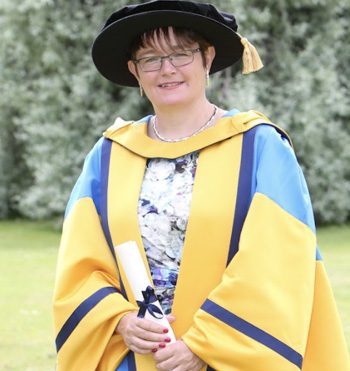Julie McEnery
UNIVERSITY COLLEGE DUBLIN
HONORARY CONFERRING
Tuesday, 16 June 2015 at 11.30 a.m.
TEXT OF THE INTRODUCTORY ADDRESS DELIVERED BY PROFESSOR LORRAINE HANLON on 16 June 2015, on the occasion of the conferring of the Degree of Doctor of Science, honoris causa on JULIE McENERY
President, distinguished guests, ladies and gentlemen,
 It is wonderful to be here today to say a few words about Julie McEnery and her contributions to astrophysics.
It is wonderful to be here today to say a few words about Julie McEnery and her contributions to astrophysics.
I first got to know Julie when she was a graduate student in the Department of Experimental Physics, here in UCD, doing her PhD work under the supervision of Professor David Fegan. She had arrived in UCD after completing her bachelors degree in physics with astrophysics at the University of Manchester.
Her PhD thesis was a study of variability in a pretty exotic type of celestial object called a ‘blazar’….and, no, that’s not a term that we physicists have appropriated from Joyce…
Her research started out using telescopes on the ground…not conventional telescopes as we usually think of them, but collectors of flashes of light that are created when ultra-high energy gamma-rays from celestial sources hit the top of our atmosphere, creating showers of secondary particles, which are then moving faster than light in the atmosphere, creating short-lived blue flashes of light in the process, which are then detected by the instrument.
It is a technique that was tested by the late Prof. Neil Porter, of UCD, who used surplus World War II search lights out in Glencullen in the early 1960’s to try to detect these flashes of light, after an initial experiment by colleagues in the UK. The technique was later brought to fruition by the late Dr. Trevor Weekes, who had been Neil’s graduate student. Trevor, with colleagues Giovanni Fazio and others in the Smithsonian, set up the Whipple telescope in Arizona, which went on to open up a new observational window on the universe.
Trevor was a valued mentor to many UCD physics graduate students who spent time at the Whipple observatory during their studies, Julie included.
Of course there is plenty of (friendly) rivalry between the ground-based gamma-ray astronomers and those (like me) who work with space-based gamma-ray instruments. The conversation, owing more perhaps to the playground than to the academy, usually goes something like: ‘Well, our energies are higher’…`Yeah, well we detect more sources’…
As Trevor noted in his book on Very High Energy Gamma-Ray Astronomy: ‘the two communities have a cultural divide and there is seldom overlap’.
After her PhD in 1997, Julie continued her work in ground-based high energy astronomy, first as a Postdoctoral Research Associate at the University of Utah, Salt Lake City and then at the University of Wisconsin. Her colleague, Dr. Neil Gehrels, recalls meeting Julie at a conference where she presented tantalising results from her experiment: “There was a signal that looked real – if so, it would be a ground-breaking discovery - but the statistics were not overwhelming. She could easily have stumbled at such an early stage in her career, by either over or under playing it, but she walked the perfect line between excitement and caution.”
Following that encounter, Julie then made the leap across that cultural divide to become a research scientist at the University of Maryland working on the ‘Fermi’ gamma-ray astronomy satellite. She was appointed to the role of deputy project scientist in 2005. Fermi, launched in 2008, is NASA's largest gamma-ray observatory and has just celebrated its 7th successful year in orbit.
Gamma-rays are the highest-energy form of light, and the gamma-ray sky is spectacularly different from the one we perceive with our own eyes. The mission has provided us with revolutionary new insights into neutron stars, supernova remnants, cosmic rays, binary systems, active galactic nuclei, and gamma-ray bursts.
Julie’s leadership role within the Fermi collaboration, which consists of hundreds of scientists from more than 40 institutions all around the world, was recognised with her appointment as Fermi project scientist in 2009. In this role, Julie provides scientific guidance and information to staff, working with all elements of the mission - from instrument teams to satellite operations. She has also, in turn, generously acted as a mentor for UCD physics graduate students.
Julie McEnery is an outstanding astrophysicist who has achieved international acclaim for her leadership role in NASA. She is a Fellow of the American Physical Society having being recognized "for her fundamental contributions to the understanding of the gamma-ray sky through her leadership of the Fermi mission as Project Scientist and her discoveries of gamma-ray burst high energy properties."
Recently, Julie has been actively supporting European scientists’ efforts to win support from the European Space Agency for a successor mission to Fermi, as well as lobbying within her own US community. It has been a pleasure to work with her on that project and I hope that this future mission will also get the opportunity to benefit from Julie’s leadership, insight and wisdom.
Praehonorabilis Praeses, totaque Universitas,
Praesento vobis hanc meam filiam, quam scio tam moribus quam doctrina habilem et idoneam esse quae admittatur, honoris causa, ad Gradum Doctoratus Scientiae; idque tibi fide mea testor ac spondeo, totique Academiae.